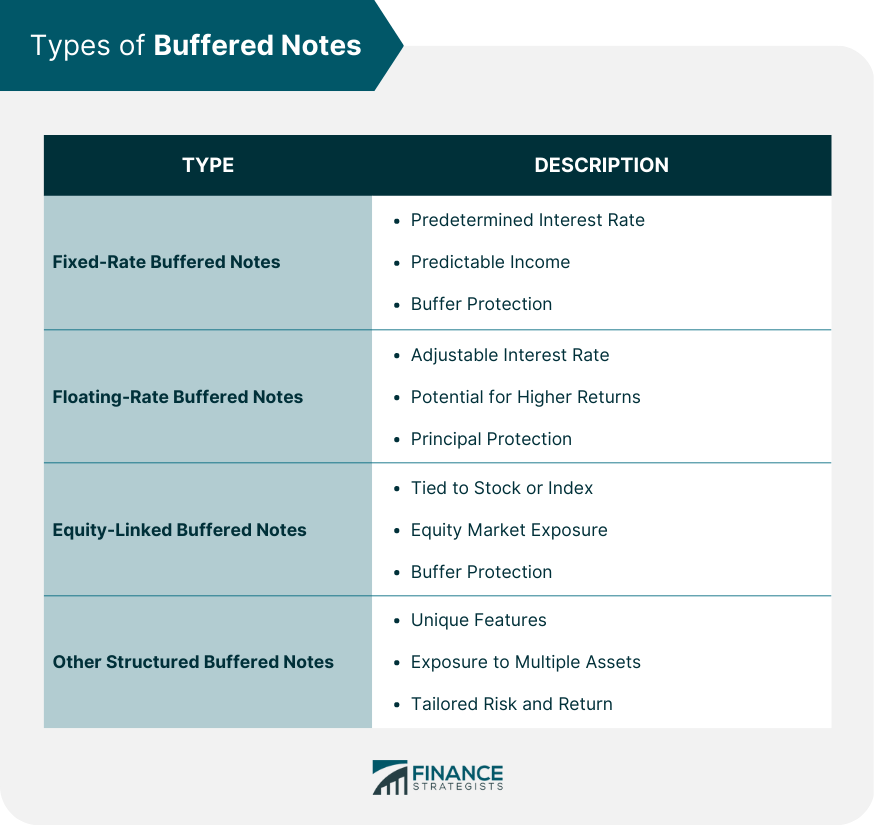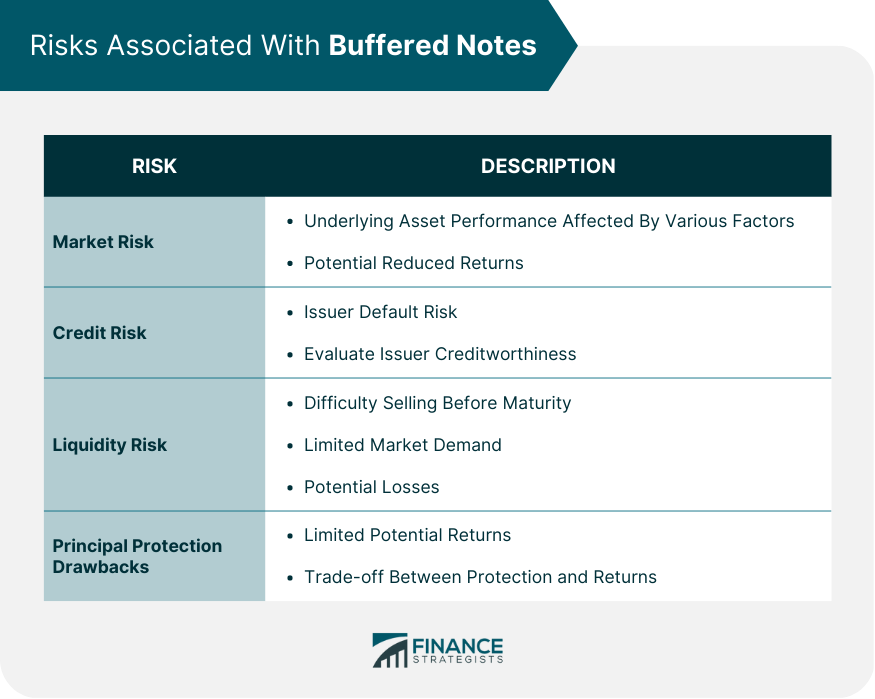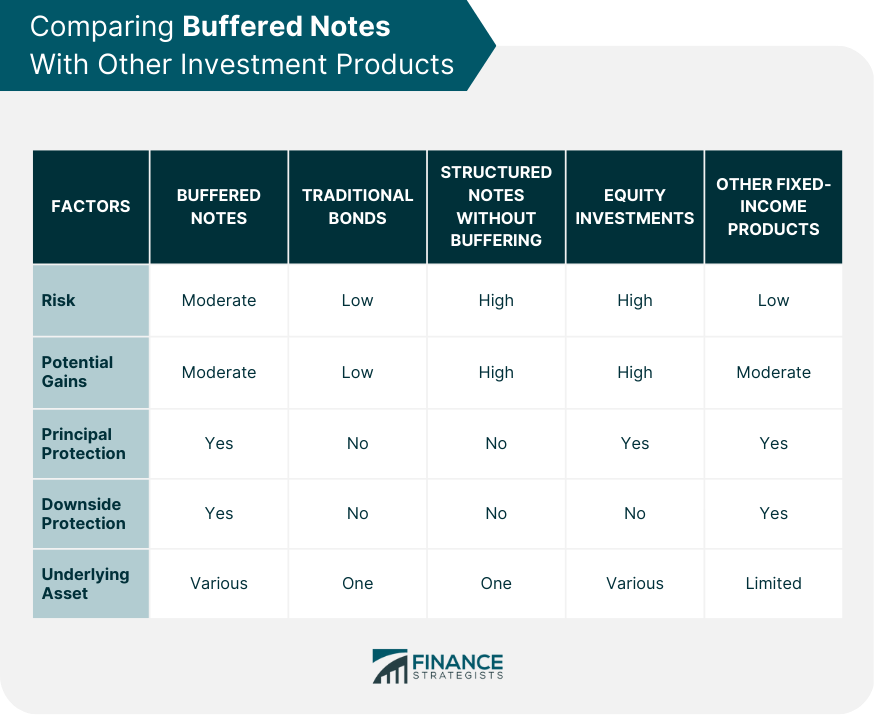Buffered notes are structured financial instruments that offer investors a level of principal protection while providing exposure to the performance of an underlying asset, such as a stock, index, or interest rate. The key feature of buffered notes is the buffer mechanism, which cushions against potential losses by absorbing a predetermined percentage of any negative returns experienced by the underlying asset. The primary purpose of buffered notes is to offer investors a way to participate in the potential gains of an underlying asset while limiting their downside risk through the buffer mechanism. This unique combination of growth potential and risk management makes buffered notes attractive for investors seeking a balance between risk and return in their investment portfolios. Some benefits of using buffered notes include the following: Principal Protection: Buffered notes typically provide a level of principal protection, ensuring that investors receive back a specified percentage of their initial investment at maturity, regardless of the asset's performance. Risk Management: The buffer mechanism limits the investor's exposure to potential losses, helping to manage the overall risk of their investment. Diversification: Buffered notes offer exposure to various underlying assets, allowing investors to diversify their portfolios and potentially enhance their overall returns. Customization: The structure of buffered notes can be tailored to meet specific investor needs and risk profiles, providing a flexible investment option. Various types of buffered notes are available to investors, each with distinct features and risk profiles. Fixed-rate buffered notes offer a predetermined interest rate paid to investors over the life of the note. These notes are ideal for investors seeking predictable income streams while still benefiting from a buffer against potential losses. Floating-rate buffered notes have interest rates that adjust periodically based on a reference rate, such as LIBOR. This type of buffered note provides investors with the potential for higher returns if interest rates rise while still offering a level of principal protection. Equity-linked buffered notes tie their performance to a specific stock or index, allowing investors to participate in potential equity market gains while still having some protection against losses through the buffer mechanism. These buffered notes may have unique features, such as exposure to multiple underlying assets or custom payout structures, providing investors with tailored investment opportunities and varying levels of risk and return. Understanding the core components of buffered notes, such as principal protection, the buffer, underlying assets, and maturity, is crucial for informed investment decision-making. Principal protection in buffered notes refers to the guarantee that investors will receive back a specified percentage of their initial investment at maturity, regardless of the underlying asset's performance. This feature provides a degree of downside protection for investors. The buffer in buffered notes serves as a cushion against potential losses, absorbing a predetermined percentage of any negative returns experienced by the underlying asset. This buffer allows investors to participate in the potential gains of the asset while limiting their downside risk. The performance of the underlying asset in buffered notes, whether a stock, index, or other asset, directly impacts the returns generated by the note. Investors must carefully assess the risks and potential rewards of the chosen asset to make informed investment decisions. Maturity refer to the length of time until the buffered note expires, at which point the principal and any accrued interest are returned to the investor. Duration, on the other hand, measures the note's sensitivity to interest rate fluctuations. Both factors are essential in determining the overall risk profile of a buffered note. Investing in buffered notes requires careful consideration of factors such as risk and return, credit risk, tax implications, and portfolio diversification benefits. Buffered notes provide a balance between risk and return by offering some principal protection while still allowing for participation in potential gains. Investors must evaluate risk tolerance and return expectations to determine if buffered notes suit their investment objectives. Credit risk refers to the possibility that the issuer of the buffered note may default on its obligations, such as interest payments or principal repayment. Investors must carefully assess the creditworthiness of the issuer and the potential impact of default on their investment. The tax treatment of buffered notes may vary depending on the investor's jurisdiction and the specific features of the note. Investors should consult a tax professional to understand the potential tax consequences of investing in buffered notes. Including buffered notes in a diversified investment portfolio can help reduce overall risk and enhance potential returns. These notes offer a combination of fixed income and equity exposure, which can balance the risk and reward profile of the portfolio. The issuance process of buffered notes involves various stages, including the role of financial institutions, regulatory requirements, pricing, and secondary market considerations. Understanding this process is essential for investors considering buffered note investments. Financial institutions, such as banks and brokerage firms, play a crucial role in issuing buffered notes. They create and structure the notes, underwrite the offering, and distribute the notes to investors through their sales channels. Buffered notes are subject to regulatory oversight and must comply with various disclosure and reporting requirements. These requirements are designed to protect investors and ensure a transparent and efficient market for these financial products. The pricing of buffered notes depends on several factors, including the creditworthiness of the issuer, the performance of the underlying asset, market conditions, and investor demand. Investors should understand the pricing process and factors that may impact the value of their investment. While some buffered notes may be traded in a secondary market, their liquidity can be limited, making it difficult for investors to sell their notes before maturity. Investors should know the potential liquidity risks associated with investing in buffered notes. Investing in buffered notes involves several risks, including market, credit, liquidity, and the potential drawbacks of principal protection. Market risk refers to the possibility that the underlying asset's performance may be negatively impacted by various factors, such as economic conditions, interest rate fluctuations, or geopolitical events. While buffered notes offer some protection against losses, investors may still experience reduced returns due to market risk. As previously mentioned, credit risk involves the possibility that the issuer may default on its obligations. Investors must evaluate the creditworthiness of the issuer and consider the potential impact of default on their investment. Liquidity risk arises when investors may not be able to sell their buffered notes before maturity due to limited market demand. This risk can lead to difficulty in realizing the value of the investment or potential losses if the investor needs to sell the note at an unfavorable price. While principal protection offers a level of downside protection, it may also limit the potential returns of the buffered note. When evaluating buffered note investments, investors should carefully consider the trade-off between principal protection and potential returns. Traditional bonds typically offer fixed income streams and lower risk profiles than buffered notes. However, buffered notes provide a combination of income and potential capital gains and some principal protection, which may be more attractive to certain investors seeking a balance between risk and return. Structured notes without buffering provide investors with exposure to the performance of an underlying asset but do not offer any principal protection. On the other hand, Buffered notes provide a buffer against potential losses, making them more suitable for investors seeking downside protection. Equity investments, such as stocks, offer the potential for capital appreciation but come with higher risk than buffered notes. Buffered notes can provide exposure to equity market gains while offering principal protection and a buffer against potential losses. Other fixed-income products, such as certificates of deposit (CDs) and government bonds, typically offer lower risk and stable income streams. However, buffered notes can provide investors with the potential for higher returns, exposure to various underlying assets, and a degree of downside protection, making them an attractive alternative for some investors. Buffered notes have gained popularity in the global financial market, with various issuers and investors worldwide. The market for buffered notes has experienced significant growth and innovation in recent years, driven by investor demand for customized investment products that balance risk and return. As the market evolves, new types of buffered notes and structures may emerge, offering additional opportunities for investors. Buffered notes are issued by various financial institutions, including banks, insurance companies, and asset managers, across different regions. Investors worldwide may have access to buffered notes, depending on local regulations and the availability of products in their markets. Global economic factors, such as interest rates, currency fluctuations, and geopolitical events, can influence the performance of underlying assets in buffered notes and, consequently, their returns. Investors should be aware of these factors and their potential impact on their investments. Regulatory requirements and tax treatment of buffered notes may vary across different jurisdictions, affecting both issuers and investors. Investors should consult with financial and tax professionals to ensure they understand the regulatory and tax implications of investing in buffered notes in their respective countries. Buffered notes are a versatile and innovative financial product that can offer investors a balance between risk and return while providing some level of principal protection. They come in various types, such as fixed-rate, floating-rate, equity-linked, and other structured buffered notes, catering to different investment needs and risk profiles. While buffered notes can provide diversification benefits to an investment portfolio, they also involve risks, such as market, credit, liquidity, and potential drawbacks of principal protection. Investors should carefully consider their risk tolerance, investment objectives, and the unique features of buffered notes when deciding whether to include them in their portfolios. As global market trends and economic factors continue to influence the performance of buffered notes, investors need to stay informed and adapt their investment strategies accordingly. If you are considering investing in buffered notes or exploring other investment opportunities, seek the guidance of professional wealth management services. A wealth manager can help you assess your financial goals, risk tolerance, and investment options, ensuring that you make informed decisions that align with your unique financial situation and objectives.What Are Buffered Notes?
Types of Buffered Notes
Fixed-Rate Buffered Notes
Floating-Rate Buffered Notes
Buffered Notes With Equity-Linked Features
Other Structured Buffered Notes

Key Components of Buffered Notes
Understanding the Buffered Notes' Principal Protection
Role of the Buffer in Buffered Notes
Importance of the Underlying Asset in Buffered Notes
Maturity and Duration of Buffered Notes
Investing in Buffered Notes
Assessing Risk and Return in Buffered Notes
Evaluating Credit Risk in Buffered Notes
Tax Implications of Investing in Buffered Notes
Diversification Benefits of Adding Buffered Notes to a Portfolio
Issuance Process of Buffered Notes
Role of Financial Institutions in Buffered Notes Issuance
Regulatory Requirements for Issuing Buffered Notes
Process of Pricing Buffered Notes
Secondary Market for Buffered Notes
Risks Associated With Buffered Notes
Market Risk in Buffered Notes Investments
Credit Risk Related to the Issuer of Buffered Notes
Liquidity Risk in Buffered Notes
Potential Drawbacks of Buffered Notes' Principal Protection

Comparing Buffered Notes With Other Investment Products
Buffered Notes vs Traditional Bonds
Buffered Notes vs Structured Notes Without Buffering
Buffered Notes vs Equity Investments
Buffered Notes vs Other Fixed-Income Products

Buffered Notes in a Global Context
Buffered Notes Market Trends and Developments
International Issuers and Investors of Buffered Notes
Impact of Global Economic Factors on Buffered Notes
Cross-Border Regulation and Taxation of Buffered Notes
Final Thoughts
Buffered Notes FAQs
Buffered notes are structured financial products that provide investors with a level of principal protection while offering exposure to the performance of an underlying asset. They are designed to balance risk and return by allowing investors to participate in potential gains while limiting downside risk through a buffer mechanism.
Buffers in buffered notes serve as a cushion against potential losses, absorbing a predetermined percentage of any negative returns experienced by the underlying asset. This buffering mechanism allows investors to benefit from the potential gains of the asset while minimizing their exposure to losses.
The main types of buffered notes include fixed-rate buffered notes, floating-rate buffered notes, equity-linked buffered notes, and other structured buffered notes. Each type has distinct features and risk profiles, catering to various investment needs and preferences.
The key risks associated with buffered notes include market, credit, liquidity, and potential drawbacks of principal protection. While buffered notes offer some level of downside protection, investors may still experience reduced returns due to these risks and should carefully assess their risk tolerance before investing.
Buffered notes offer a unique combination of fixed income and equity exposure, which can balance an investment portfolio's risk and reward profile. They provide some principal protection and the potential for higher returns compared to traditional bonds and other fixed-income products while still offering less risk than direct equity investments or structured notes without buffering.
True Tamplin is a published author, public speaker, CEO of UpDigital, and founder of Finance Strategists.
True is a Certified Educator in Personal Finance (CEPF®), author of The Handy Financial Ratios Guide, a member of the Society for Advancing Business Editing and Writing, contributes to his financial education site, Finance Strategists, and has spoken to various financial communities such as the CFA Institute, as well as university students like his Alma mater, Biola University, where he received a bachelor of science in business and data analytics.
To learn more about True, visit his personal website or view his author profiles on Amazon, Nasdaq and Forbes.











